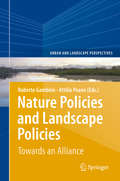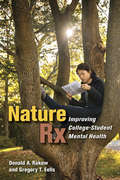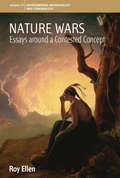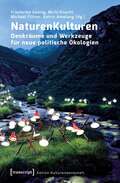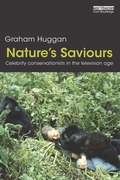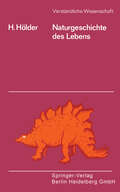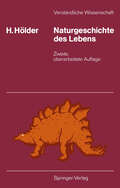- Table View
- List View
Nature Pleads Not Guilty: The 1972 Case History
by Rolando V. GarciaDrought and Man: The 1972 Case History, Volume 1: Nature Pleads Not Guilty is a two-part volume that mainly focuses on the social and climatic dimensions of drought. The first part of this book presents facts that are accurate and fake, as well as misleading casual links, about the 1972 Soviet case history. This part also discusses social crises such as malnutrition, famines, and drought, including responses to these problems. The second part considers climate and climatic variability, including some thoughts on these topics. This book will be invaluable to historians, sociologists, and academicians interested in studying the social and climatic dimensions of drought.
Nature Policies and Landscape Policies: Towards an Alliance (Urban and Landscape Perspectives #18)
by Roberto Gambino Attilia PeanoThe book focuses on the relationship between nature conservation policies and landscape policies. This is a relevant subject due to the current need of reviving nature conservation policies, which are today affected by a general effectiveness deficiency. To this end, landscape policies can play a crucial role, bridging nature and culture, fostering more integrated approaches to nature conservation and stimulating the active participation of local communities.The book gathers reflections, researches and experiences developed on an international level on this subject by experts coming from different international contexts (Europe, U.S.A.), various disciplinary backgrounds (geographers, planners, biologists, historians, jurists, economists, etc.) and several institutional bodies (Universities, administrative bodies, international organizations such as IUCN, EUROPARC Federation, UNESCO, etc.). The overall reflections gathered in the book - which is divided in three main sections: regulations and institutional frameworks, policies, actions and tools - combine to suggest innovative visions about the relationships between nature policies and landscape policies.
Nature Rx: Improving College-Student Mental Health
by Donald A. Rakow Gregory T. EellsThe Nature Rx movement is changing campus life. Offering alternative ways to deal with the stress that students are under, these programs are redefining how to provide students with the best possible environment in which to be healthy, productive members of the academic community. In Nature Rx, Donald A. Rakow and Gregory T. Eells summarize the value of nature prescription programs designed to encourage college students to spend time in nature and to develop a greater appreciation for the natural world. Because these programs are relatively new, there are many lessons for practitioners to learn; but clinical studies demonstrate that students who regularly spend time in nature have reduced stress and anxiety levels and improved mood and outlook.In addition to the latest research, the authors present a step-by-step formula for constructing, sustaining, and evaluating Nature Rx programs, and they profile four such programs at American colleges. The practical guidance in Nature Rx alongside the authors' vigorous argument for the benefits of these programs for both students and institutions places Rakow and Eells at the forefront of this burgeoning movement.
Nature, Society, and Marginality: Case Studies from Nepal, Southeast Asia and other regions (Perspectives on Geographical Marginality #8)
by Pushkar K. Pradhan Walter LeimgruberThis book focuses on the interrelations between nature and humans, in particular on those segments of societies that have been left behind (marginal groups). Nature is both the friend of humans and their adversary, depending on the way people treat and use it. Consequently, the book adopts a wide perspective of marginality: nature that has been marginalized by man (ecological marginality), but also social groups marginalized by politics, economic interests, and value judgements imbedded in culture. Many chapters deal specifically with issues in Nepal, but along with the other chapters with case studies from Southeast Asia and other regions, they demonstrate that the major man-nature problems are the same everywhere and can only be solved by constructive politics through clear regulations, convincing actions and general acceptance.
Nature, Tourism and Ethnicity as Drivers of: Insights to Marginality from Perspective of Sustainability and Development (Perspectives on Geographical Marginality #3)
by Stanko Pelc Miha KodermanThis book considers de-marginalization attesting that marginal regions have the potential for de-marginalization and are anchored in developmental terms on the following core themes: nature; tourism; ethnicity and general factors including migration. Adding to the discussion on marginality and sustainability this book contributes a number of case studies on a diverse selection of topics and regions in which these crucial issues connect. It delivers a reflection of (de)marginalizing processes in today’s globalized world where an increasing number of people, groups, societies and regions are marginalized and vulnerable not only from social and economic factors, but also from natural causes such as natural hazards. This book addresses the unsustainable practices in the past that have often generated difficult conditions for sustainable development in the future. Marginal regions that have not been developed are given much needed consideration as they may now enjoy the benefits of having not been exploited in the past to their present-day developmental advantage. The overview offered by this book is significant in that marginal regions with relatively unspoiled and attractive natural (and cultural) landscapes have a great potential for sustainable tourism. Contributions include the (de)marginalization of ethnic groups, the role of education and migration in the process, and different economic and political perspectives. Considering the topics covered, the book should be appreciated by all those involved in creation of social policies, urban and regional planning – coordinating economic with spatial and social development and by those studying in the fields were competencies for such activities are important part of the study program.
Nature, Value, Duty: Life on Earth with Holmes Rolston, III (The International Library of Environmental, Agricultural and Food Ethics #8)
by Christopher J. Preston Wayne OuderkirkThis is a collection of contemporary writings on the work of Holmes Rolston, III. The authors contributing to this volume are a mixture of senior scholars in environmental ethics and new voices in philosophy and in literature. Together they provide an in depth evaluation of many of the topics discussed by Rolston. Rolston himself, in a detailed reply to each of his critics at the end of the volume, reveals where some of these criticisms sting him the most.
Nature Wars: Essays Around a Contested Concept (Environmental Anthropology and Ethnobiology #27)
by Roy EllenOrganized around issues, debates and discussions concerning the various ways in which the concept of nature has been used, this book looks at how the term has been endlessly deconstructed and reclaimed, as reflected in anthropological, scientific, and similar writing over the last several decades. Made up of ten of Roy Ellen’s finest articles, this book looks back at his ideas about nature and includes a new introduction that contextualizes the arguments and takes them forward. Many of the chapters focus on research the author has conducted amongst the Nuaulu people of eastern Indonesia.
NaturenKulturen: Denkräume und Werkzeuge für neue politische Ökologien (Edition Kulturwissenschaft #146)
by Friederike Gesing Michi Knecht Michael Flitner Katrin AmelangWas haben Moskitonetze in Ghana mit Küstenschutz in Neuseeland oder Rohmilchkäseproduktion in den USA gemeinsam? Was verbindet Plastikmüll in den Meeren mit der Frage, ob Fleisch von Tieren stammt? Dieser Band vermittelt Einblicke in ein neues Forschungsfeld an der Schnittstelle von Kultur- und Sozialanthropologie, Geografie und Science & Technology Studies und stellt mit den »NaturenKulturen« ein Konzept vor, mit dem sich das Verhältnis von Natur und Kultur neu bestimmen und politisch situieren lässt. Beiträge von Anna Tsing, Steve Hinchliffe, Uli Beisel, Banu Subramaniam, Sven Bergmann und anderen laden dazu ein, »NaturenKulturen« als Denkraum zu verstehen und neue Konstellationen von ökologischen Prozessen, technischen Artefakten und mehr-als-menschlichen Akteuren zu erforschen.
Nature's End: History and the Environment
by S. Sörlin P. WardeEnvironmental History as a distinct discipline is now over a generation old, with a large and diverse group of practitioners around the globe. This book provides a reflection on the achievements, diversity, and direction of environmental history in its varied national, international and continental contexts.
Nature's Hidden Charms: 50 Signs, Symbols and Practices from the Natural World to Bring Inner Peace, Protection and Good Fortune
by Liz DeanFeaturing folklore, symbology and practical rituals alongside ancient crafts and modern techniques this beautifully illustrated book contains over 50 creative ways to use the gifts of the natural world to make charms, talismans, amulets, altars and much more. These natural offerings provide us with protection, good fortune and healing.Being in nature helps us to relax and connect with our innate knowing. When we're connected, we naturally want to collect: a pink shell, sycamore key, a pinecone, or a pure white pebble that calls to us. Nature's Hidden Charms is an invitation to reach into the natural world, understand folklore and to explore and discover the hidden symbols and gifts that even the tiniest twig or stone can bring.Inside this treasure trove you will learn how to:• Prepare to open the senses to intentionally connect with nature• Create and make amulets, charms, alters, talismans and natural mandalas• Work with plants, trees and herbs throughout the seasons• Understand the folklore, history and symbology surrounding the plants and practices featured• Recognise and explore symbols that speak to you in the natural worldFrom making a healing lavender pouch to evoking the sacred power of the circle or arranging your charms as a mandala for meditation, this book is for anyone wanting to slow down, connect with nature and enjoy the simple pleasures of the natural world.
Nature's Saviours: Celebrity Conservationists in the Television Age
by Graham HugganToday's celebrity conservationists, many of whom made their reputations through television and other visual media, play a major role in drawing public attention to an increasingly threatened world. This book, one of the first to address this contribution, focuses on five key figures: the English naturalist David Attenborough, the French marine adventurer Jacques-Yves Cousteau, the American primatologist Dian Fossey, the Canadian scientist-broadcaster-activist David Suzuki, and the Australian 'crocodile hunter' Steve Irwin. Some of the issues the author addresses include: What is the changing relationship between western conservation and celebrity? How has the spread of television helped shape and mediate this relationship? To what extent can celebrity conservation be seen as part of a global system in which conservation, like celebrity, is big business? The book critically examines the heroic status accorded to the five figures mentioned above, taking in the various discourses – around nature, science, nation, gender – through which they and their work have been presented to us. In doing so, it fills in the cultural, historical and ideological background behind contemporary celebrity conservationism as a popular expression of a chronically endangered world.
Nature's Saviours: Celebrity Conservationists in the Television Age
by Graham HugganToday's celebrity conservationists, many of whom made their reputations through television and other visual media, play a major role in drawing public attention to an increasingly threatened world. This book, one of the first to address this contribution, focuses on five key figures: the English naturalist David Attenborough, the French marine adventurer Jacques-Yves Cousteau, the American primatologist Dian Fossey, the Canadian scientist-broadcaster-activist David Suzuki, and the Australian 'crocodile hunter' Steve Irwin. Some of the issues the author addresses include: What is the changing relationship between western conservation and celebrity? How has the spread of television helped shape and mediate this relationship? To what extent can celebrity conservation be seen as part of a global system in which conservation, like celebrity, is big business? The book critically examines the heroic status accorded to the five figures mentioned above, taking in the various discourses – around nature, science, nation, gender – through which they and their work have been presented to us. In doing so, it fills in the cultural, historical and ideological background behind contemporary celebrity conservationism as a popular expression of a chronically endangered world.
Naturgeschichte des Lebens (Verständliche Wissenschaft #93)
by Helmut HölderDieses kleine Buch sei dem Homo sapiens gewidmet, der seit dem großen und bescheidenen DAR WIN gelernt hat, in der Welt fossilen Lebens auch die Leitlinien seines eigenen Werdens zu erkennen. Es will in knapper Fassung in den Wissensstand und die Problematik der stammesgeschichtlichen Paläontologie einführen, nachdem E. DAQUE und E. THENIUS in den Bänden 4 und 8 r dieser Reihe eine allgemeinere Darstellung über "Das fossile Lebewesen" und "Versteinerte Urkunden" gegeben haben. Dabei sollen auch einige schon historisch gewordene Erkenntnisschritte in Erinne rung gebracht werden. Endlich soll die naturwissenschaftlich ge wonnene Einsicht zum Selbstverständnis des Menschen in Be ziehung gesetzt werden, das sie einerseits prägend mitbestimmt, von dem sie andererseits aber auch begrenzt wird. HELMUT HöLDER Münster fWestf. Inhalt Natur als Geschichte? . . Schichtgesteine sind Geschichtsbücher 3 Kleiner historischer Exkurs . . . . . Noch einmal: Geschichte in Schichtsteinen 8 Vom Anfang des Lebens . . . . . . . . 9 Leben und Umwelt - Lamarckismus und Darwinismus I I Mutation und Auslese . . . . I 8 Der metaphysische Porenraum I 9 Das Gleichgewicht des Lebens 2I Einzigartigkeit des irdischen Lebens 2 3 Tier-und Pflanzenwelt . . . . . . 24 Aus der Geschichte der wirbellosen Tiere. 29 Schwämme und Korallen . . . . . 29 Entfaltung der höheren Wirbellosen 40 Mollusken 43 Gliedertiere . 57 Stachelhäuter 59 Graptolithen . 6 3 Die Entfaltung der Wirbeltiere 65 Fische . . . . . . 66 Der Schritt an Land 7I Lurche . . . . . . 76 Saurier . . . . . .
Naturgeschichte des Lebens: von seinen Anfängen bis zum Menschen (Verständliche Wissenschaft #93)
by Helmut HölderDiese auch für den Laien verständliche Einführung in die Naturgeschichte gibt einen Einblick in den derzeitigen Wissensstand und die Problematik der stammesgeschichtlichen Paläontologie. Nach kurzer Einleitung in Wesen und Wissenschaftshistorie, mit besonderem Nachdruck auf den glücklichen Umstand der so reichlich vorhandenen fossilen Überlieferungen, wird die Evolution der Pflanzen- und, etwas ausführlicher, der Tierwelt anhand der wichtigsten Organismengruppen dargestellt - ohne den Leser durch Formenfülle zu entmutigen. Dabei erfährt die Beziehung der Lebewesen zu ihrer Umwelt und dem Hin und Her der Anpassungen an Wasser, Land und Luft besondere Betonung. Einbezogen in das Gesamtgeschehen der Evolution wird auch der Mensch, sowohl in seiner physischen Entwicklung als auch in seinem Wesen und Selbstverständnis bis hin zu seiner heute ins Blickfeld gerückten Umweltverantwortung.
Naturkatastrophen und individuelles Verhalten in Entwicklungsländern: Risiko, Vertrauen und die Nachfrage nach Mikroversicherungen
by Oliver FialaDiese Studie untersucht den komplexen Zusammenhang zwischen Naturkatastrophen, individuellem Verhalten - in Form von individueller Risikobereitschaft und Vertrauensniveau - und der Nachfrage nach Mikroversicherungen. Entwicklungsländer sind besonders anfällig für die Auswirkungen von Naturkatastrophen und Klimawandel, da diese ihre Entwicklungsprozesse beeinträchtigen und die Bemühungen zur Armutsbekämpfung zurückwerfen. Unter Verwendung eines einzigartigen Datensatzes für das ländliche Kambodscha, der auf einer Umfrage, experimentellen Spielen und einem diskreten Auswahlexperiment basiert, unterstreicht die Studie die Bedeutung von Wahrnehmungen, Erwartungen und psychologischen Faktoren in Entscheidungsprozessen mit erheblichen Folgen für langfristige wirtschaftliche Perspektiven und die Armutsbekämpfung.
Naturkatastrophen und Risikomanagement: Geowissenschaften und soziale Verantwortung
by Ulrich RankeMit der Covid-19-Pandemie hat die Menschheit zu den bekannten Ereignissen in der Natur wie den extremen Hochwasserereignissen an Elbe und Oder, dem Tsunami in Indonesien, Erdbeben in Italien oder ersten deutlichen Anzeichen für einen Anstieg des Meeresspiegels ein Katastrophenszenario zu bewältigen, das ihre Bedrohung noch einmal nachhaltig verstärkt. In Europa werden die Menschen zunehmend mit Gefahren konfrontiert, die sich nicht irgendwo auf der Welt abspielen, sondern im eigenen Umfeld. Und der Klimawandel wird die schon bestehenden Probleme noch weiter verstärken, mit unabsehbaren Folgen für Ökonomie, Gesellschaft und die Natur. Der Einzelne sieht sich immer stärker der Frage gegenübergestellt, inwieweit er davon persönlich betroffen sein wird. (Natur-)Katastrophen sind zu einem grundlegenden Bestandteil der Daseinsvorsorge geworden. Das vorliegende Buch soll kein geologisches, geographisches oder geophysikalisches Lehrbuch sein, sondern stellt den Menschen in den Mittelpunkt der Betrachtung. So werden die Naturkatastrophen unter dem Aspekt betrachtet, wer wie und in welchem Ausmaß davon betroffen sein kann. Es wird ein Nexus von Wissenschaft und den politischen Entscheidungsträgern hergestellt und hierzu wird der Sachverstand der Experten eingefordert.Naturkatastrophen und Risikomanagement basiert auf dem englischsprachigen Buch Natural Disaster Risk Management – Geosciences and Social Responsibility aus dem Jahr 2016. Der Autor nutzte die Gelegenheit, den deutschen Text vor dem Hintergrund der sich seit Erscheinen der englischsprachigen Version deutlich erweiterten Erkenntnisbasis grundlegend zu überarbeiten und umfassend zu erweitern. Es wurden einige Schwerpunkte anders gesetzt, vor allem aber viele Aussagen neu gefasst und präzisiert.
Naturparke als Manager einer nachhaltigen Regionalentwicklung: Probleme, Potenziale und Lösungsansätze (RaumFragen: Stadt – Region – Landschaft #9)
by Friedericke WeberNaturparke sind die älteste Schutzgebietskategorie in Deutschland, sie nehmen jedoch im Vergleich zu Nationalparken und Biosphärenreservaten in der Außenwahrnehmung einen eher nachgeordneten Platz ein. Durch das Bundesnaturschutzgesetz wurde ihnen die komplexe Aufgabe der nachhaltigen Regionalentwicklung zugesprochen. Friedericke Weber analysiert auf der Basis eines handlungstheoretischen Ansatzes, der die Strukturationstheorie von Giddens mit dem akteurzentrierten Institutionalismus von Mayntz und Scharpf verbindet, Probleme, die Naturparke daran hindern (können), nachhaltige Regionalentwicklung zu betreiben. Sie arbeitet ihre Potenziale heraus und skizziert Lösungen, wie Naturparke ihre Aufgabe als Regionalmanager erfüllen können.
Naturschutz – Landschaft – Heimat: Romantik als eine Grundlage des Naturschutzes in Deutschland
by Nils Magnus FrankeDer deutsche Naturschutz wird aktuell in der öffentlichen Wahrnehmung eng mit dem Fach Ökologie bzw. den Naturwissenschaften verbunden. Diese Annahme kennzeichnet jedoch eine vergleichsweise neue Entwicklung: Denn bis etwa 1970 dominierte im Naturschutz vor allem eine romantische Weltsicht mit all ihren schönen, aber auch gefährlichen Aspekten. Erst mit dem Entstehen der Umweltbewegung wurde der Paradigmenwechsel in Richtung Naturwissenschaften eingeleitet und verankert. Aber wie wirksam war diese Veränderung? Verfolgen Naturschützer und ihre Verbände wie NABU oder BUND heute wirklich naturwissenschaftlich fundierte Konzepte, wie sie immer wieder vorgeben? Dieses Buch weist nach, dass der deutsche Naturschutz auch heute noch in vielen zentralen Arbeitsfeldern romantische und damit nicht-naturwissenschaftliche Positionen vertritt und entsprechend argumentiert. Gleichzeitig gelingt die Weiterentwicklung eines wissenssoziologischen Konzeptes: Das Konzept der Lebenswelten im Sinne von Alfred Schütz wird um die der Fantasie erweitert.
Naturwissenschaften um 1800: Wissenschaftskultur in Jena–Weimar
Im Raum Jena-Weimar bildeten sich um 1800 wesentliche Aspekte des heutigen Konzepts von Naturwissenschaften heraus. Der Band zeichnet diese Entwicklungen unter den Rubriken »Naturphilosophie und Wissenschaften«, »Strukturen wissenschaftlicher Gesellschaften und Sammlungen« und »Rezeption der Jenaer Naturwissenschaft« nach. Für ein Verständnis der Entwicklung der Naturwissenschaften ist die Analyse der Wissenschaftskultur in Jena-Weimar um 1800 zentral. Der Band versucht, diese eingehender darzustellen. Im ersten Teil »Naturphilosophie und Wissenschaften« wird der Bogen von Grundbegriffen der Naturphilosophie und exemplarischen Ausführungen zu einzelnen naturphilosophischen Konzeptionen hin zur Bedeutung der Wissenschaften vom Menschen für die Philosophie dieser Zeit geschlagen. Im zweiten Teil »Strukturen wissenschaftlicher Gesellschaften und Sammlungen« wird die Bedeutung dieser Strukturen für die Entwicklung der Wissenschaften in Jena aufgezeigt. Abschließend wird der repräsentative Status der Jenaer-Weimar Kultur um 1800 für die Entwicklung der Naturwissenschaften zu Beginn des 19. Jahrhunderts bewertet.
The Naughty Nineties: The Triumph of the American Libido
by David FriendA sexual history of the 1990s when the Baby Boomers took over Washington, Hollywood, and Madison Avenue. A definitive look at the captains of the culture wars -- and an indispensable road map for understanding how we got to the Trump Teens.The Naughty Nineties: The Triumph of the American Libido examines the scandal-strafed decade when our public and private lives began to blur due to the rise of the web, reality television, and the wholesale tabloidization of pop culture. In this comprehensive and often hilarious time capsule, David Friend combines detailed reporting with first-person accounts from many of the decade's singular personalities, from Anita Hill to Monica Lewinsky, Lorena Bobbitt to Heidi Fleiss, Alan Cumming to Joan Rivers, Jesse Jackson to key members of the Clinton, Dole, and Bush teams. The Naughty Nineties also uncovers unsung sexual pioneers, from the enterprising sisters who dreamed up the Brazilian bikini wax to the scientists who, quite by accident, discovered Viagra.
The Naughty Nineties: The Triumph of the American Libido
by David FriendA sexual history of the 1990s when the Baby Boomers took over Washington, Hollywood, and Madison Avenue. A definitive look at the captains of the culture wars -- and an indispensable road map for understanding how we got to the Trump Teens.The Naughty Nineties: The Triumph of the American Libido examines the scandal-strafed decade when our public and private lives began to blur due to the rise of the web, reality television, and the wholesale tabloidization of pop culture. In this comprehensive and often hilarious time capsule, David Friend combines detailed reporting with first-person accounts from many of the decade's singular personalities, from Anita Hill to Monica Lewinsky, Lorena Bobbitt to Heidi Fleiss, Alan Cumming to Joan Rivers, Jesse Jackson to key members of the Clinton, Dole, and Bush teams. The Naughty Nineties also uncovers unsung sexual pioneers, from the enterprising sisters who dreamed up the Brazilian bikini wax to the scientists who, quite by accident, discovered Viagra.
The Naughty Nineties: Football's Coming Home
by Martin King Martin KnightFootball has reinvented itself. As television money has poured into the game, the traditional working-class fans have poured out - not by choice, but by economic necessity. According to those in charge of the game the football hooligan has at last been eliminated from the landscape. But how true is this much-vaunted claim? Martin King, author of Hoolifan, brings his story up to date in The Naughty Nineties. Ironically, he finds that football hooligans now really are in the minority but they are far more dangerous and committed than ever before.
Navaho Religion: A Study of Symbolism
by Gladys Amanda ReichardIn this in-depth exploration of the symbols found in Navaho legend and ritual, Gladys Reichard discusses the attitude of the tribe members toward their place in the universe, their obligation toward humankind and their gods, and their conception of the supernatural, as well as how the Navaho achieve a harmony within their world through symbolic ceremonial practice.Originally published in 1963.The Princeton Legacy Library uses the latest print-on-demand technology to again make available previously out-of-print books from the distinguished backlist of Princeton University Press. These editions preserve the original texts of these important books while presenting them in durable paperback and hardcover editions. The goal of the Princeton Legacy Library is to vastly increase access to the rich scholarly heritage found in the thousands of books published by Princeton University Press since its founding in 1905.
Navajo Infancy: An Ethological Study of Child Development
by James S. ChisholmNavajo Infancy describes the major sources of change and continuity in Navajo infant development. It does so by combining concepts and methods of classical ethology with those of social-cultural anthropology. The goal is to establish the relationships between human nature and culture. Buy considering the nature of adaptation, and the evolution of human developmental patterns, and through analyses of the determinants of change and continuity in Navajo infant development, Navajo Infancy outlines how the process of development itself may bridge nature and culture.With its special focus on the effect of the cradleboard on Navajo mother-infant interaction, Navajo Infancy raises important developmental issues in its analyses of why the eff ects of the cradleboard do not last. Incorporating the Brazelton Neonatal Behavioral Assessment Scale into its ethological-anthropological methods, Navajo Infancy demonstrates signifi cant Navajo-Anglo-American differences in newborn temperament. It fi nds a strong correlation between newborn behavior and prenatal environmental factors, arguing that racial and ethnic differences in behavior at birth go well beyond simple gene pool differences.Navajo Infancy also describes the individual and group differences in the development of Navajo and Anglo- American children's fear of strangers and patterns of mother-infant interaction. Aspects of attachment theory, transactional theories of development, and anthropological theories of socialization are related to this broad new evolutionary approach to the process of development and nature-culture interaction.
Navajo Infancy: An Ethological Study of Child Development
by James S. ChisholmNavajo Infancy describes the major sources of change and continuity in Navajo infant development. It does so by combining concepts and methods of classical ethology with those of social-cultural anthropology. The goal is to establish the relationships between human nature and culture. Buy considering the nature of adaptation, and the evolution of human developmental patterns, and through analyses of the determinants of change and continuity in Navajo infant development, Navajo Infancy outlines how the process of development itself may bridge nature and culture.With its special focus on the effect of the cradleboard on Navajo mother-infant interaction, Navajo Infancy raises important developmental issues in its analyses of why the eff ects of the cradleboard do not last. Incorporating the Brazelton Neonatal Behavioral Assessment Scale into its ethological-anthropological methods, Navajo Infancy demonstrates signifi cant Navajo-Anglo-American differences in newborn temperament. It fi nds a strong correlation between newborn behavior and prenatal environmental factors, arguing that racial and ethnic differences in behavior at birth go well beyond simple gene pool differences.Navajo Infancy also describes the individual and group differences in the development of Navajo and Anglo- American children's fear of strangers and patterns of mother-infant interaction. Aspects of attachment theory, transactional theories of development, and anthropological theories of socialization are related to this broad new evolutionary approach to the process of development and nature-culture interaction.

